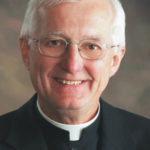By Michele Kueter Petersen
SAU Theological Perspective

I journeyed to Avila, Spain last October to participate in a conference on St. Teresa Benedicta of the Cross (Edith Stein) at the pontifical Universidad Católica Santa Teresa de Jesús, which sits on a hill overlooking the old walled city of Avila. It is the last intact medieval city wall of its kind in Europe, built in the 11th century. I also saw the room where St. Teresa of Avila was born, located off a side chapel in the Basilica of Santa Teresa, built over the site of her family home.
It seemed surreal to be in Avila. I had lost my mother three months before and the pain was visceral. However, when I walked onto the small balcony outside the room of the hotel on the grounds of the university where my spouse and I stayed, I had the experience of déjà vu. It felt like I was looking out onto the prairie and fields outside the second-story bedroom window of my childhood home on the edge of the small eastern Iowa town where I grew up. I was worlds away from home and yet I felt a beautiful convergence of time and space as my spiritual formation has taken place under the auspices of both Mom and the Carmelites.
St. Teresa of Avila, along with her contemporary, St. John of the Cross, are central figures of the Roman Catholic Reformation in 16th-century Spain. She is an inspiring and timely figure for our day, who lived a remarkable life of interior solitude even as she engaged in frequent communication and extensive travel that her position demanded. She entered the Monastery of the Incarnation in Avila in 1535 and became prioress in 1571. With enthusiasm and plenty of humor, as her letters reveal, she proceeded to reform existing Carmelite religious communities and began new foundations as well.
Teresa penned her well-known work, “The Interior Castle,” in 1577, two years after having been denounced to the Inquisition. The work’s sheer exuberance draws the reader into the journey that Teresa depicts of a person who travels to the center of the soul, where God dwells. Her language evokes bridal mysticism, drawing from The Song of Songs tradition that begins with Origen.
He regards that scriptural text as a wedding song, illustrative of divine love for humanity; it is personal love within the context of community. Human love is therefore a metaphor for divine/human love. His Homily XXVII on Numbers depicts the Word of God as the true food, with faith and knowledge, together with deeds and works, forming the flow of life that is contemplation and action. This tradition is passed down through Bernard of Clairvaux and eventually to the Carmelite reformers.
Teresa describes the interior life of one who has set out and traveled through the seven dwelling places of the interior castle. The traveler approaches and enters the castle’s door through prayer. Teresa speaks “to the magnificent beauty of a soul and its marvelous capacity” for God (I.1.1). We should be “already secure with the blessed,” that is, we already possess what we are in search of (III.1.1). Any darkness we experience is due to our attachments rather than flaws (I.2.14). We are creatures and not our Creator as she is careful to distinguish.
Our graced efforts enable us to travel through the first three dwelling places. Growth in love, the essence of the spiritual life, can come about in the beginning stages of prayer through sermons, books and other people (II.I.3). Teresa attributes dryness in prayer to lack of humility (III.1.6). We work through this dryness so that we heal, lest we become stuck here for the rest of our lives.
At this point, prayer transitions from meditation to contemplation as Teresa distinguishes between spiritual consolations (contentos), which begin in us and end in God (meditation), and spiritual delights (gustos), which originate in God as freely given and in which we participate (contemplation) (IV.1.4; IV.2.3; IV.2.4).
An ongoing surrendering to God’s will results in the expansion of our interior being. An emptiness has become fullness of God (VII.2.7; VII.3.4; VII.3.5). As we enter this innermost dwelling place of the interior castle, we understand “the Most Blessed Trinity…” (VII.1.6). This spiritual marriage occurs after the spiritual union in which Christ’s humanity has been revealed (VII.2.1).
We receive the gift of an intellectual vision, a mutual indwelling, the spiritual marriage (VII.1.6 and VII.2.3). This “fire of love” can burn so intensely in us that it enkindles and awakens in others a desire to grow in love of God (VII.4.14). This journey in prayer, which leads to self-knowledge and knowledge of God, culminates in love of God and love of neighbor (VII.4.7; VII.4.8; VII.4.14). The growth of love in the interior of our being has an exterior correlative in the growth in love we have for all others, and in the love with which we serve and do our work (VII.4.14). To benefit another person in some way is to give honor, glory and praise to God (VII.3.2; VII.3.8; VII.4.2; VII.4.3).
As an addendum, I made a trip with my mom and dad to New Melleray Abbey one gorgeous autumn day when I was working on my doctorate. When we returned to the car, they surprised me with an early birthday present, the first volume of St. Teresa of Avila’s letters. My dad inscribed the book on that day, October 7, 2006. Fast forward to last fall: I presented my paper at Avila on Oct. 7. When I realized this recently, it brought comfort and joy to my grieving, for just as the Song of Songs says, “love is strong as death” (8:6).
(Michele Kueter Petersen, Ph.D., is a lecturer in theology and philosophy at St. Ambrose University in Davenport.)











